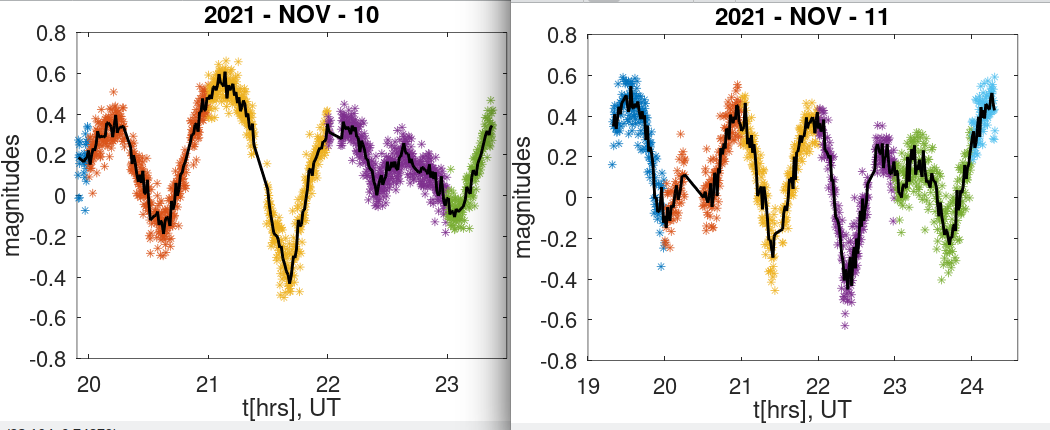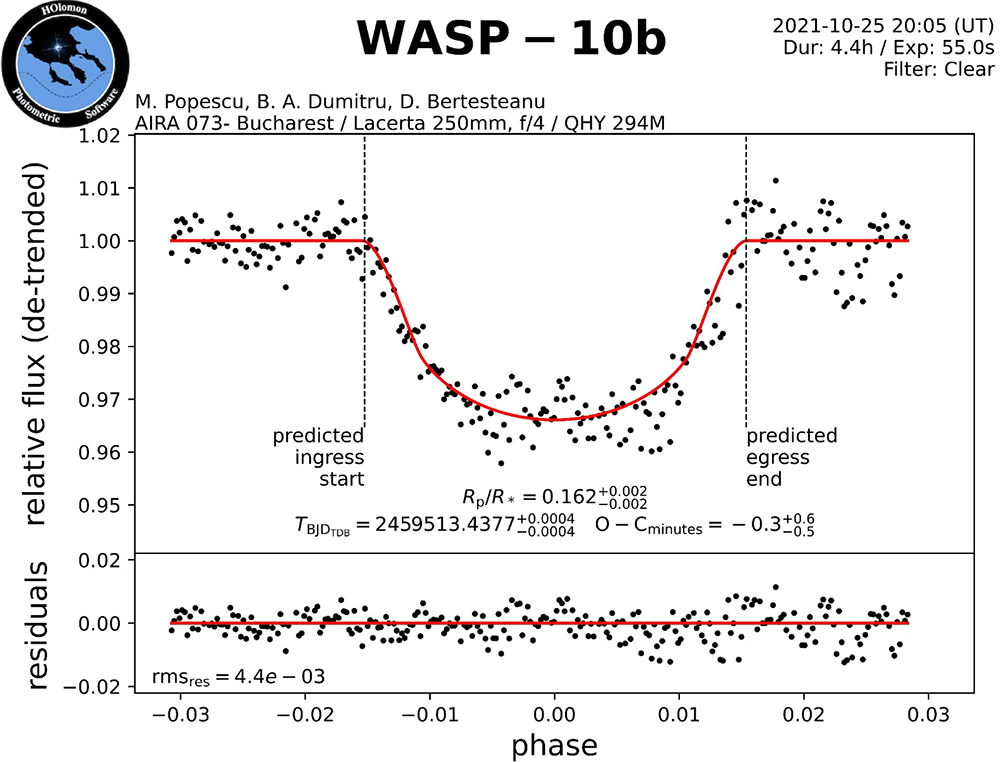The T025 – BD4SB a pro-am collaboration for planetary sciences
- 1Astroclubul București, Bulevardul Lascăr Catargiu 21, 010663 Bucharest, Romania
- 2Astronomical Institute of the Romanian Academy, Research, Bucharest, Romania
- 3Faculty of Sciences, University of Craiova, Craiova, Romania
- 4Institute of Space Science (ISS), 409, Atomistilor Street, 077125 Măgurele, Ilfov, Romania
- 5Colegul Național Mihai Viteazul, Bulevardul Pache Protopopescu 62, Bucharest 021414, Romania
- 6Faculty of Physics, Bucharest University, 405 Atomiștilor str, Măgurele 077125, Ilfov, Romania
The technological progress of electronic, optic and mechanic domains brought high performance astronomy equipment at affordable prices for student and amateur astronomers. As a result, the amateur astronomers contribution to scientific publications has increased exponentially (e.g. Knapen 2011, Mousis et al. 2013). For example, various transient events and long term monitoring of celestial bodies can be observed with a telescope having an aperture of 0.2-0.5 m, and CCD or CMOS detector (e.g. Gherase et al. 2015).
Also, such equipment allows to attract students for a career in science and technology. The "astronomical concepts and images have universal appeal, inspiring wonder and resonating uniquely with human questions about our nature and our place in the universe" (National Academies Press, 2021). Thus, we believe that fundamental concepts related to the scientific method can be learned by a student who comes with questions related to celestial bodies, makes his own observations, processes the acquired images, analyzes the obtained data, and then presents his new findings to the community.
Motivated by these facts we developed T025 – BD4SB telescope. The acronym is represented by the aperture of the telescope (0.25 m) and the project through which we financed its acquisition (Big Data for Small Bodies). We installed this robotic telescope on the roof of the old Bucharest Astronomical Institute. This location corresponds to Minor Planet Center observatory code 073. Here we describe the setup, highlight some of the obtained results, and we discuss the perspectives.
Setup
The components of the instrument are: a Lacerta 250/1000 Newtonian telescope mounted on a Sky Watcher EQ6 Pro Go-To equatorial mount, a 14 bit QHY 294M Medium Size Cooled CMOS Camera, and a mini PC Beelink computer for controlling the setup. Including the auxiliaries (guiding telescope and camera, cables, and adapters) the cost of this setup was about 6k euros (as of 2020). Additionally, a permanent internet connection and electrical power are needed. This setup gives a field of view of 44x66 arcminutes, and a projected pixel size of 0.956 arcesc/pixel.
Fig.1 The T025 – BD4SB prepared for observations.
The full control of this instrument is made using the Nighttime Imaging 'N' Astronomy – NINA software interface (https://nighttime-imaging.eu/). The data reduction is performed using the IRAF and its PyRAF counterpart in Python. We designed a general pipeline based on Python scripts to perform the bias and flat corrections, to find the astrometric solution using Source Extractor and SCAMP software, and to retrieve the photometry of all sources in the images. All data is stored on a dedicated server and we intend to make it online available. Additionally, we use Astrometrica, Tycho, MPO Canopus and HOPS (HOlomon Photometric Software) programs for specific tasks.
The median magnitude limit is ~20 V band magnitude. Because we are observing from a light polluted area (although we are located in the Carol Park from Bucharest, and the area is surrounded by a lot of trees), the sky brightness varies between the seasons, and consequently the limiting magnitudes are in the range of 19 – 20.7. These limiting magnitudes could be obtained in about ~15 min total exposure time, and they are imposed by the brightness of the sky. The median seeing is ~2.8 arcsec, but the range of variability is 1.8 -4 arcsec.
Observations and results
The objectives of our project is to obtain high quality astrometric and photometric data which can be used for university student projects (including those for bachelor thesis and master thesis) and for participating in scientific publications. Thus, we make the following types of observations: 1) astrometric observations of asteroids and comets, prioritizing the newly discovered NEAs or those with uncertain orbits; 2) photometric observations of Solar System bodies with the aim to obtain accurate light-curves for deriving the spin-properties and their shape; 3) the occultations which are performed in various international campaigns; 4) follow-up of various exoplanets transits; 5) light-curves of variable stars.
We reported more than 100 observations to the Minor Planet Center. These include three confirmations of newly discovered NEAs, and the participation to the IAWN campaign for 2019 XS (Farnochia et al. 2022). We obtained the light-curves and rotation-periods for four NEAs, designated 4660, 153591, 12711, 2019 XS. We obtained more than 65 hours of data for asteroid (4660)Nereus which (Mansour et al. EPSC 2022).
One of the challenging observation was obtained during the nights of November 10-11, 2021 for the NEA 2019 XS (absolute magnitude of 23.87). The object moved with an apparent rate of 20-30 arcsec/min, so we could use an exposure time of 5-10 sec and we had to change the field several times during the night. The result (Fig. 2) shown strong evidences that 2019 XS is a tumbling asteroid. 
Fig.2 The light-curves obtained for 2019 XS. Colors correspond to different fields and the black line is a median of every 9 points.
Another result we highlight is the four transits we observed for exoplanets TOI-1259Ab, WASP-10b, HAT-P-3b. The lightcurves were submitted to TRESCA-Exoplanets (http://var2.astro.cz/EN/tresca/) database. They show that such setup can obtain photometric measurements with a precision in the range of mili-magnitudes for targets as faint as 14. 
Fig.3 The transit of WASP-10b exoplanet .
Acknowledgments
This work was supported by a grant of the Romanian National Authority for Scientific Research – UEFISCDI, project number PN-III-P1-1.1- TE-2019-1504, contract number TE 173/23/20/2002.
References
1. Johan H. Knapen 2011, Proceedings of ”Stellar Winds in Interaction”
2. Mousis et al. 2014, Experimental Astronomy, Volume 38, Issue 1-2, pp. 91-191
3. Radu-Mihai Gherase et al. 2015, Romanian Astronomical Journal, Vol. 25, No. 3, p.241
4. Astronomy and Astrophysics in the New Millennium; The National Academies Press. https://doi.org/10.17226/9839
5. Farnochia et al. 2022, PSJ, accepted
How to cite: Nicolae Berteșteanu, D., Popescu, M., Mihai Gherase, R., Alexandru Mansour, J., Alexandru Dumitru, B., Stanciu, B., Perrotta, A., H. Naiman, M., Blagoi, O., Dumitru, T., and Lupoae, A.: The T025 – BD4SB a pro-am collaboration for planetary sciences, Europlanet Science Congress 2022, Granada, Spain, 18–23 Sep 2022, EPSC2022-1222, https://doi.org/10.5194/epsc2022-1222, 2022.

